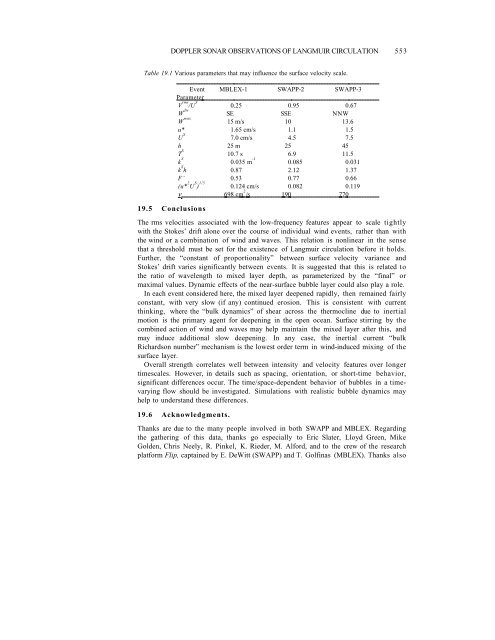552 JEROME A. SMITHU S 1 ≈ ( ak) 2c p = T ( ak) 2g / 4π ≈( const.)T(19-8)2For the SWAPP-3 event, the peak wave period was estimated in a variety <strong>of</strong> ways[Bullard and Smith 1996], leading to a favored value <strong>of</strong> about 11.5 s near the end <strong>of</strong> theevent; thus, we set the value <strong>of</strong> (ak) 2 by matching to that value in that event. Thecorresponding value for (ak) 2 is 0.0084, well within reason. The effective wavenumberis then computed from T S via linear dispersion: ks= ( 2π/ Ts) 2 / g. Given theuncertainty in defining a “peak period,” and given the purported importance <strong>of</strong> waveStokes’ drift to the generation <strong>of</strong> <strong>Langmuir</strong> <strong>circulation</strong>, this proxy for the wave periodand length scales appears to be most appropriate.As reported in Table 19.1, the directions <strong>of</strong> MBLEX-1 and SWAPP-2 are similar, butthe V-scaling differs by the largest ratio. This appears to rule out both the opposingswell and the horizontal Coriolis hypotheses. The estimated wave-induced viscosity islargest for SWAPP-3, but this is intermediate in V-scaling. Another possibility issuppression <strong>of</strong> motion by bubble buoyancy. The level <strong>of</strong> breaking presumably sets theoverall density <strong>of</strong> the near surface bubble-cloud. A likely indicator <strong>of</strong> this is set bymatching the rise-rate <strong>of</strong> the largest bubbles to the wave breaking turbulent velocityscale (as discussed above in connection with the turbulent eddy viscosity). Comparingthis with the observed velocity scaling, it is seen that this parameter at least has theright ordering in magnitude, although the MBLEX-1 and SWAPP-3 values are relativelyclose. Finally, there is the “scale depth” kh <strong>of</strong> the mixed layer. It is important todistinguish here between the development <strong>of</strong> ∆V, V rms , h, U S , and k over the course <strong>of</strong> anevent versus the differences between events. These all develop in parallel over thecourse <strong>of</strong> a wind event; however, what is <strong>of</strong> interest at the moment is whether theydevelop either at different rates or from different initial values between events. It isthese latter differences between events that presumably set the ratio <strong>of</strong> V rms to U S overthe event. Thus it is emphasized that this “scaled depth” refers to final or quasiequilibriumvalues <strong>of</strong> h and k S .One way the scaled depth could influence the result is that the layer-averagedconvergent force should be subtracted from the surface value, since this works todepress the thermocline rather than drive <strong>circulation</strong>. For roughly exponential decaywith the depth-scale <strong>of</strong> the Stokes’ drift, this leads to a net force at the surface reducedby the factor01 −2kz−1 −2khF′ = F0−F ≈1− ∫ e dz = 1−( 2kh) ( 1−e)h(9)−hNote that this varies smoothly from 0 at kh=0 to 1 as kh gets large; in other words, thewind-wave forcing mechanism is reduced for very thin layers, and reaches the fullpredicted strength as the mixed layer becomes deeper than the wave’s scale-depth. Asseen, the effect is in the right direction, but is again too weak to explain the fulldifferences observed between the three events. It appears that further investigations areneeded to select between the alternatives and to determine why and when suppression <strong>of</strong>the motion occurs.
DOPPLER SONAR OBSERVATIONS OF LANGMUIR CIRCULATION 553Table 19.1 Various parameters that may influence the surface velocity scale.19.5 ConclusionsEvent MBLEX-1 SWAPP-2 SWAPP-3ParameterV rms /U S 0.25 0.95 0.67W dir SE SSE NNWW max 15 m/s 10 13.6u* 1.65 cm/s 1.1 1.5U S 7.0 cm/s 4.5 7.5h 25 m 25 45T S 10.7 s 6.9 11.5k S 0.035 m -1 0.085 0.031k S h 0.87 2.12 1.37F’ 0.53 0.77 0.66(u* 2 U S ) 1/3 0.124 cm/s 0.082 0.119ν t 698 cm 2 /s 190 770The rms velocities associated with the low-frequency features appear to scale tightlywith the Stokes’ drift alone over the course <strong>of</strong> individual wind events, rather than withthe wind or a combination <strong>of</strong> wind and waves. This relation is nonlinear in the sensethat a threshold must be set for the existence <strong>of</strong> <strong>Langmuir</strong> <strong>circulation</strong> before it holds.Further, the “constant <strong>of</strong> proportionality” between surface velocity variance andStokes’ drift varies significantly between events. It is suggested that this is related tothe ratio <strong>of</strong> wavelength to mixed layer depth, as parameterized by the “final” ormaximal values. Dynamic effects <strong>of</strong> the near-surface bubble layer could also play a role.In each event considered here, the mixed layer deepened rapidly, then remained fairlyconstant, with very slow (if any) continued erosion. This is consistent with currentthinking, where the “bulk dynamics” <strong>of</strong> shear across the thermocline due to inertialmotion is the primary agent for deepening in the open ocean. Surface stirring by thecombined action <strong>of</strong> wind and waves may help maintain the mixed layer after this, andmay induce additional slow deepening. In any case, the inertial current “bulkRichardson number” mechanism is the lowest order term in wind-induced mixing <strong>of</strong> thesurface layer.Overall strength correlates well between intensity and velocity features over longertimescales. However, in details such as spacing, orientation, or short-time behavior,significant differences occur. The time/space-dependent behavior <strong>of</strong> bubbles in a timevaryingflow should be investigated. Simulations with realistic bubble dynamics mayhelp to understand these differences.19.6 Acknowledgments.Thanks are due to the many people involved in both SWAPP and MBLEX. Regardingthe gathering <strong>of</strong> this data, thanks go especially to Eric Slater, Lloyd Green, MikeGolden, Chris Neely, R. Pinkel, K. Rieder, M. Alford, and to the crew <strong>of</strong> the researchplatform Flip, captained by E. DeWitt (SWAPP) and T. Golfinas (MBLEX). Thanks also


